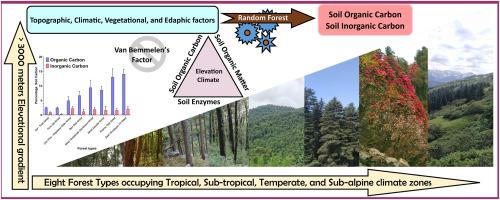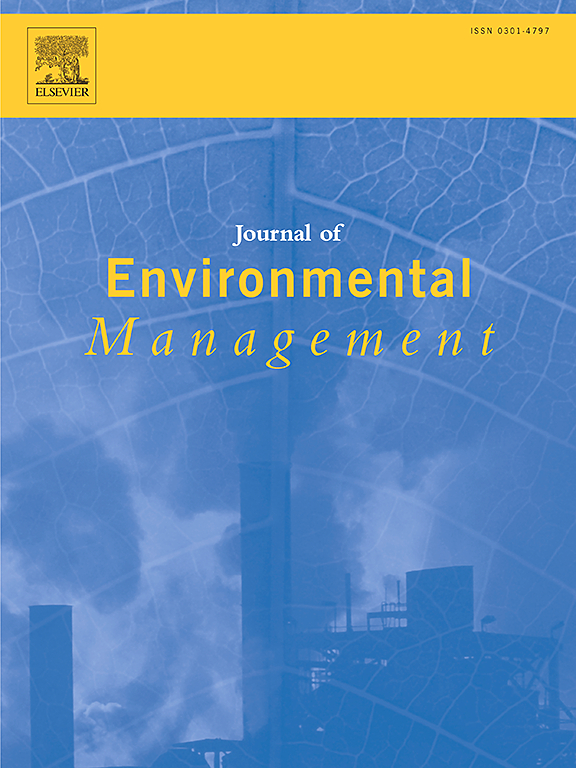Inclusive Indian Central Himalayan soil carbon estimates underscores significant inorganic carbon contribution and temporal dynamics: Implications for carbon sequestration
IF 8
2区 环境科学与生态学
Q1 ENVIRONMENTAL SCIENCES
引用次数: 0
Abstract
Soil carbon estimates in the Indian Himalayan region—a global climate change hotspot—primarily rely on the lossy wet oxidation method and predominantly focus on soil organic carbon (SOC), neglecting the soil inorganic carbon (SIC) component. Sensitive and holistic soil carbon estimates are crucial for effective policy planning. By incorporating eight major Central Himalayan forest types along a 3000 m elevational gradient, we report that the acidic Himalayan soil (surface soil pH: 4.74–6.84) of the selected forest types hold up to 31% of the total soil carbon stock as SIC stock. Using soil carbon and soil organic matter assays based on elemental analyzer and the loss-on-ignition method, we established that these Himalayan soils store less than 50% of SOC in SOM, challenging the use of universal factors in the region. The amount of SOC in SOM also showed temporal variability. The machine learning Random Forest algorithm highlighted the influence of SOM and climate variables in regulating the distribution of SOC, microbial biomass carbon, and key carbon cycling soil enzymes. The vertical distribution of SOC was more uniform than that of SIC. We found higher activity of soil carbon-cycling enzymes (dehydrogenase, beta-glucosidase, and phenol oxidase) in the forest types. Sensitive and higher soil carbon estimates substantiate a lower microbial quotient (0.17–1.23 %) than the regional trend. Notably, we explained how seasonal and temporal changes in soil carbon estimations hinder a constant positive soil carbon flux. Meanwhile, the mean surface SOC flux (4.63 Mg C ha−1 yr−1) and SIC flux (1.68 Mg C ha−1 yr−1) indicate that the Himalayan soils have significant potential for carbon sequestration. In conclusion, our research indicates substantial soil organic and inorganic carbon storage in major Central Himalayan forest types, with negative anthropogenic activities posing a clear and present threat to the soil carbon stocks.

对印度喜马拉雅中部土壤碳含量的全面估算强调了无机碳的重要贡献和时间动态:对碳螯合的影响。
印度喜马拉雅地区是全球气候变化的热点地区,该地区的土壤碳估算主要依赖于有损湿氧化法,而且主要侧重于土壤有机碳(SOC),而忽视了土壤无机碳(SIC)的成分。敏感而全面的土壤碳估算对于有效的政策规划至关重要。通过将喜马拉雅山中部海拔 3000 米梯度上的八个主要森林类型纳入其中,我们发现所选森林类型的喜马拉雅山酸性土壤(表层土壤 pH 值:4.74-6.84)的 SIC 碳储量占土壤总碳储量的 31%。通过使用基于元素分析仪和点火损失法的土壤碳和土壤有机质检测,我们确定这些喜马拉雅山土壤的 SOC 储量不到 SOM 的 50%,这对该地区使用通用因子提出了挑战。SOM 中的 SOC 量还表现出时间上的可变性。机器学习随机森林算法强调了 SOM 和气候变量在调节 SOC、微生物生物量碳和关键碳循环土壤酶分布方面的影响。与 SIC 相比,SOC 的垂直分布更为均匀。我们发现森林类型土壤碳循环酶(脱氢酶、β-葡萄糖苷酶和酚氧化酶)的活性更高。敏感和较高的土壤碳估算值证实了微生物商数(0.17-1.23%)低于区域趋势。值得注意的是,我们解释了土壤碳估算值的季节性和时间性变化如何阻碍了土壤碳通量的恒定正值。同时,平均地表 SOC 通量(4.63 兆克碳/公顷-年-1)和 SIC 通量(1.68 兆克碳/公顷-年-1)表明喜马拉雅土壤具有巨大的固碳潜力。总之,我们的研究表明,喜马拉雅山中部主要森林类型的土壤有机碳和无机碳储量巨大,而人类活动对土壤碳储量构成了明显的威胁。
本文章由计算机程序翻译,如有差异,请以英文原文为准。
求助全文
约1分钟内获得全文
求助全文
来源期刊

Journal of Environmental Management
环境科学-环境科学
CiteScore
13.70
自引率
5.70%
发文量
2477
审稿时长
84 days
期刊介绍:
The Journal of Environmental Management is a journal for the publication of peer reviewed, original research for all aspects of management and the managed use of the environment, both natural and man-made.Critical review articles are also welcome; submission of these is strongly encouraged.
 求助内容:
求助内容: 应助结果提醒方式:
应助结果提醒方式:


